6 Underground Animals and Their Habits
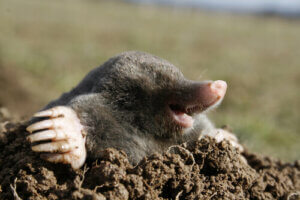
The species that live underground are known as ‘edaphic’, and, save for rare cases, they don’t come to the surface. These underground animals were able to adapt to the lack of light and oxygen in such a way that some are even born with their eyes covered with skin. Learn about some of these species in this article.
Amazing underground animals
It amazes us that there are creatures able to survive underground. Moreover, they find coming to the surface dangerous and try to avoid it as much as possible. Below, we’ll tell you which are the most curious underground animals.
1. Moles
When we think of life underground, the image of a mole automatically comes to mind, with its small and almost blind eyes, its ‘backward looking’ legs and its long muzzle.
The mole is like a bulldozer and can make very deep holes in a matter of minutes. Once underground, its nose helps it find food —mainly worms— and escape from danger.
2. Earthworms
As we’re talking about mole food, we also make reference to earthworms. This is another of the well-known underground species. Earthworms belong to the annelid family and are capable of digging tunnels as they search for food.
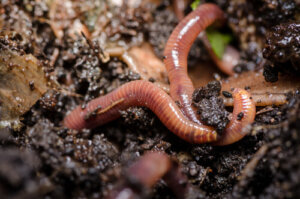
They’re endowed with skin breathing, so they need to be in a humid environment. Therefore, they often come to the surface at night. Earthworms are voracious: they can ingest up to 90% of their body weight per day… and they don’t have any teeth!
3. Pink armadillos
This mammal also known as ‘pichiciego’ is the smallest of the entire armadillo family —it measures about 4 inches— and it’s named after its pale pink shell. Moreover, it displays white hairs on its belly.
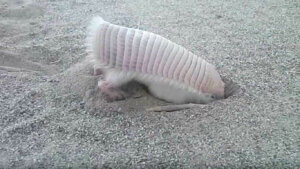
It’s a nocturnal animal that only comes to the surface to look for food: ants, larvae, snails, worms, roots, or plants. If it feels threatened it can dig in the ground and escape through subterranean tunnels. It’s very difficult to find a pink armadillo because it spends almost no time ‘in the open air’, and because its population has declined quite a bit.
4. Scorpions
Scorpions are other underground animals that, fortunately in this case, aren’t seen too much on the surface. These arthropods, directly related to the arachnids, are characterized by their hands in the shape of claws and their tail that ends in a stinger with which they can inject venom.
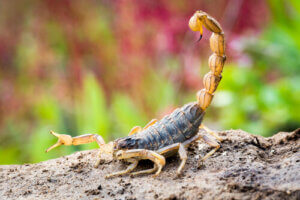
They live in sandy and rocky terrains and hide underground during the day to avoid becoming prey to birds, snakes, or lizards. They feed on insects and spiders, stalking prey around their shelters.
5. Gerbils
The Mongolian gerbil, or Mongolian jird, is a small rat-like rodent mammal that lives in dry and sandy areas in China and Mongolia. During the day, it rests and protects itself from dangers in very deep burrows in the ground. It goes out at night to look for food, especially vegetables and seeds.

The gerbil has a long tail and plenty of hair, even though they’re bald when born. It’s a fairly territorial animal, especially females during the fertile phase, but this doesn’t prevent it from becoming an increasingly popular pet in Asia.
6. Ants
Finally, ants are one of the most impressive underground species, due to their ability to work as a team and the number of specimens that can live in the same colony.
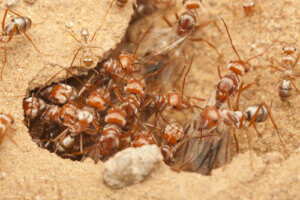
Ants create their ‘home’ by digging into the ground, but they also pile up different materials above the surface. Those famous mounds alert us of their presence. Inside the anthill lives the queen, the drones, the larvae and the workers, all in harmony and each dedicated to its specific task.
The species that live underground are known as ‘edaphic’, and, save for rare cases, they don’t come to the surface. These underground animals were able to adapt to the lack of light and oxygen in such a way that some are even born with their eyes covered with skin. Learn about some of these species in this article.
Amazing underground animals
It amazes us that there are creatures able to survive underground. Moreover, they find coming to the surface dangerous and try to avoid it as much as possible. Below, we’ll tell you which are the most curious underground animals.
1. Moles
When we think of life underground, the image of a mole automatically comes to mind, with its small and almost blind eyes, its ‘backward looking’ legs and its long muzzle.
The mole is like a bulldozer and can make very deep holes in a matter of minutes. Once underground, its nose helps it find food —mainly worms— and escape from danger.
2. Earthworms
As we’re talking about mole food, we also make reference to earthworms. This is another of the well-known underground species. Earthworms belong to the annelid family and are capable of digging tunnels as they search for food.

They’re endowed with skin breathing, so they need to be in a humid environment. Therefore, they often come to the surface at night. Earthworms are voracious: they can ingest up to 90% of their body weight per day… and they don’t have any teeth!
3. Pink armadillos
This mammal also known as ‘pichiciego’ is the smallest of the entire armadillo family —it measures about 4 inches— and it’s named after its pale pink shell. Moreover, it displays white hairs on its belly.

It’s a nocturnal animal that only comes to the surface to look for food: ants, larvae, snails, worms, roots, or plants. If it feels threatened it can dig in the ground and escape through subterranean tunnels. It’s very difficult to find a pink armadillo because it spends almost no time ‘in the open air’, and because its population has declined quite a bit.
4. Scorpions
Scorpions are other underground animals that, fortunately in this case, aren’t seen too much on the surface. These arthropods, directly related to the arachnids, are characterized by their hands in the shape of claws and their tail that ends in a stinger with which they can inject venom.

They live in sandy and rocky terrains and hide underground during the day to avoid becoming prey to birds, snakes, or lizards. They feed on insects and spiders, stalking prey around their shelters.
5. Gerbils
The Mongolian gerbil, or Mongolian jird, is a small rat-like rodent mammal that lives in dry and sandy areas in China and Mongolia. During the day, it rests and protects itself from dangers in very deep burrows in the ground. It goes out at night to look for food, especially vegetables and seeds.

The gerbil has a long tail and plenty of hair, even though they’re bald when born. It’s a fairly territorial animal, especially females during the fertile phase, but this doesn’t prevent it from becoming an increasingly popular pet in Asia.
6. Ants
Finally, ants are one of the most impressive underground species, due to their ability to work as a team and the number of specimens that can live in the same colony.

Ants create their ‘home’ by digging into the ground, but they also pile up different materials above the surface. Those famous mounds alert us of their presence. Inside the anthill lives the queen, the drones, the larvae and the workers, all in harmony and each dedicated to its specific task.
All cited sources were thoroughly reviewed by our team to ensure their quality, reliability, currency, and validity. The bibliography of this article was considered reliable and of academic or scientific accuracy.
- Sandoval-Comte, A. & López-Luna, M. (sf) Cecilias: ¿Lombriz, serpiente o desliz… de la naturaleza?. Recuperado el 8 de enero de 2022, disponible en: https://www.inecol.mx/inecol/index.php/es/2013-06-05-10-34-10/17-ciencia-hoy/1141-cecilias-lombriz-serpiente-o-desliz-de-la-naturaleza
This text is provided for informational purposes only and does not replace consultation with a professional. If in doubt, consult your specialist.








